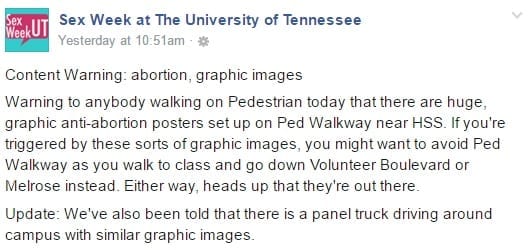Pro-life display sparks controversy with UT students
The Genocide Awareness Project displayed graphic images on Pedestrian Walkway on March 23 and March 24.

The Genocide Awareness Project displays images of fetuses and genocide while students stand on the opposite side in peaceful protest.
[title_box title=”Pro-life display sparks controversy with UT students”]
The Pro-Life Collegians of the University of Tennessee brought an organization called the Genocide Awareness Project to visit Pedestrian Walkway. The group displayed graphic images of fetuses as well as images of victims of genocides on March 23 and March 24.
Many UT students stood on the opposite side of Pedestrian Walkway holding signs that said, “Freedom of Choice” and “For safe choices we will fight,” depicting the students’ collective feelings about the display.

“We wanted to show students here that no matter what they choose, no matter what their beliefs are, we support them in their right to choose,” Victoria Long, co-chair of Sexual Health Advisory Group of UT said.
“Of course we’re all for choice, but not when those choices kill other human beings,” Fletcher Armstrong, Southeast Region Director of the Center of Bio-Ethical Reform said. “You can’t talk about the morality of abortion unless you include in the discussion the victims. The victim is so often left out of the discussion.”
Since 1998, GAP has been visiting campuses across the United States.
“When groups of people commit acts like this against other groups, they always, almost always, try to justify their actions by saying that the victims were not really human,” Armstrong said.
He said some people, not all, do change their minds on how they view abortion, and that is what they are trying to facilitate.
Protesting students found images of the Holocaust and Rwandan genocide to be offensive to those of Jewish faith and students on campus who had experienced the Rwandan genocide. The students protesting also found it offensive to students who have suffered miscarriages or have had abortions. They requested those images be taken down.

“Nobody wants to have an unwanted pregnancy. Nobody wants to have an abortion. It is a decision people come to on their own and we need to trust people and their medical care providers that they are making the right decision for themselves,” Long said.
Many students avoided Pedestrian Walkway. Brittany Edralin, a senior majoring in nutrition at UT, has seen this display multiple times in the past. She said she avoids walking on Pedestrian Walkway so she doesn’t see what images are displayed.
“I do believe in the freedom of speech. So those people do have a right to put those pictures up and say whatever they want to. I think it would be more appropriate if they had like a graphic image warning, or something. But overall, can I full on say that they should take that stuff down? Maybe not.” Edralin said.
Correction: June 15, 2016
The previous quote, “You can’t talk about the morality of *a person* unless you include in the discussion the victims. The victim is so often left out of the discussion,” was corrected to its intended statement.
Featured image by Drew LaFasto
Edited by Courtney Anderson
Drew LaFasto manages the Tennessee Journalist Facebook page and contributes articles for the news website. She is a senior in journalism at the University of Tennessee and works as a video editor at WBIR. With a broadened scope of passions within the realm of journalism, LaFasto enjoys all media formats as well as combining them. When she isn't at work or at school, she is most likely playing video games, looking at weather maps or making art. She aspires to become a meteorologist at a news station or the National Weather Service.

